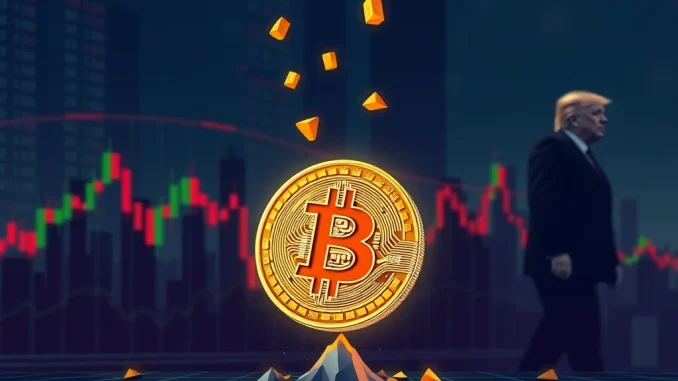
Buckle up, crypto enthusiasts! The rollercoaster ride continues as Bitcoin experienced a sudden downturn, dropping over 2% to around $77,000. What’s the culprit this time? None other than the re-emergence of trade tensions sparked by new tariffs imposed by former U.S. President Donald Trump. This unexpected move has sent ripples across both crypto and traditional financial markets, injecting a fresh dose of volatility into the already shaky economic landscape. Let’s dive into what’s causing this market tremor and what it means for your crypto portfolio.
Trump Tariffs Trigger Crypto Market Jitters: What Happened?
The news broke like a thunderclap – new tariffs from Donald Trump. According to reports from The Block, these tariffs have instantly heightened market uncertainty. But how exactly do tariffs impact the crypto sphere, particularly Bitcoin? Here’s a breakdown:
- Investor Sentiment Soured: Tariffs are generally perceived negatively by investors as they can lead to increased costs for businesses, potentially impacting profitability and economic growth. This negative sentiment spills over into riskier assets like cryptocurrencies.
- Traditional Market Correlation: Bitcoin, despite its aspirations of being a decentralized and uncorrelated asset, often mirrors movements in traditional markets, especially the stock market. When traditional markets react negatively to tariff news, Bitcoin tends to follow suit.
- Global Liquidity Concerns: Tariffs can disrupt global trade flows and potentially reduce overall liquidity in the financial system. Less liquidity often means less capital flowing into speculative assets like crypto.
Essentially, Trump’s tariffs have acted as a catalyst, exacerbating existing anxieties and prompting investors to reassess their risk exposure. This reassessment often leads to a flight from riskier assets, including Bitcoin, towards safer havens.
Decoding Market Volatility: Why is Bitcoin So Sensitive?
Why does news about tariffs cause such pronounced market volatility in Bitcoin? It boils down to a few key factors:
- Speculative Nature: Bitcoin, and the broader crypto market, is still considered a speculative asset class. This means its price is heavily influenced by investor sentiment and future expectations, making it more prone to sharp swings in response to macroeconomic news.
- Institutional Involvement: While institutional adoption is growing, a significant portion of Bitcoin trading is still driven by retail investors who can be more reactive to news headlines and market sentiment.
- Narrative Dependence: The crypto market is heavily narrative-driven. News events, whether positive or negative, can quickly shape the prevailing narrative around Bitcoin, influencing its price trajectory. In this case, tariffs create a narrative of economic uncertainty and risk aversion.
Therefore, even though Bitcoin is designed to be independent of traditional financial systems, its current market behavior demonstrates a strong sensitivity to macroeconomic events and overall market sentiment.
Macroeconomic Trends and Bitcoin’s Fate: A Tangled Web
The current situation underscores the undeniable link between macroeconomic trends and Bitcoin’s performance. Analysts have been consistently pointing out that Bitcoin’s price is not operating in a vacuum. Factors like:
- Rising Treasury Yields: When yields on government bonds rise, they become more attractive to investors seeking safer returns. This can draw capital away from riskier assets like Bitcoin.
- Shrinking Risk Appetite: Events like tariff announcements often trigger a broader “risk-off” sentiment in the market. Investors become less willing to take on risks, leading to selling pressure on assets perceived as risky, including crypto.
- Investor Uncertainty: Uncertainty is the enemy of markets. Tariffs inject uncertainty into the economic outlook, making investors hesitant and prompting them to reduce exposure to volatile assets like Bitcoin.
These macroeconomic trends create a challenging environment for Bitcoin. While some staunch believers maintain that Bitcoin is a hedge against economic uncertainty, its recent price action suggests otherwise, at least in the short term.
Crypto Markets Under Pressure: Beyond Bitcoin
It’s not just Bitcoin feeling the heat. The broader crypto markets are also experiencing pressure. Ethereum and other altcoins are often even more volatile than Bitcoin, and they tend to amplify Bitcoin’s price movements. This means that when Bitcoin dips due to factors like tariffs, altcoins can experience even steeper declines.
The interconnectedness of the crypto market means that negative sentiment in one area can quickly spread throughout the ecosystem. Therefore, the impact of Trump’s tariffs is not isolated to Bitcoin alone; it’s contributing to a broader risk-off environment across the entire crypto landscape.
Bitcoin: Digital Gold or Speculative Gamble?
Despite the current turbulence, the long-term narrative of Bitcoin as a digital store of value persists. Proponents argue that in the face of economic uncertainty and potential currency devaluation, Bitcoin offers a safe haven. However, the current market behavior raises questions about this narrative, at least in the short to medium term.
Here’s a balanced perspective:
| Argument for Bitcoin as Digital Store of Value | Counter Argument (Current Scenario) |
|---|---|
| Decentralized and limited supply, making it resistant to inflation in the long run. | Short-term price action is heavily influenced by macroeconomic events and market sentiment. |
| Potential hedge against traditional financial system risks. | Currently behaving more like a risk-on asset, correlated with traditional markets. |
| Growing institutional adoption and infrastructure development. | Investor uncertainty and risk aversion are currently outweighing long-term adoption narratives. |
Ultimately, whether Bitcoin acts as a true digital store of value in the face of global economic shifts remains to be seen. The current market volatility highlights the ongoing debate and the complex interplay of factors influencing Bitcoin’s price.
Navigating the Volatile Waters: Actionable Insights for Crypto Investors
So, what should crypto investors do amidst this tariff-induced market volatility?
- Stay Informed: Keep a close watch on macroeconomic news, particularly developments related to trade and tariffs. Understand how these events can impact market sentiment and risk appetite.
- Manage Risk: Assess your portfolio risk and consider reducing exposure to highly volatile assets if you are uncomfortable with the current market uncertainty. Diversification can be a useful tool.
- Long-Term Perspective: If you are a long-term believer in Bitcoin and crypto, try to avoid knee-jerk reactions to short-term market fluctuations. Focus on the long-term fundamentals and potential of the technology.
- Dollar-Cost Averaging: Consider dollar-cost averaging (DCA) if you plan to continue investing in Bitcoin. DCA can help mitigate the impact of volatility by averaging out your purchase price over time.
- Seek Professional Advice: If you are unsure about how to navigate the current market environment, consider consulting with a financial advisor who understands the crypto market.
Conclusion: Riding the Crypto Storm
The recent Bitcoin price drop triggered by Trump’s tariffs serves as a stark reminder of the crypto market’s sensitivity to global economic and political events. While the long-term potential of Bitcoin and blockchain technology remains compelling, the journey is likely to be filled with volatility and uncertainty. Understanding the interplay between macroeconomic trends, market volatility, and the evolving narrative around crypto markets is crucial for navigating these turbulent waters. Stay informed, manage your risk, and remember that in the world of crypto, volatility is often the name of the game. The key is to weather the storms and stay focused on the long-term horizon.



